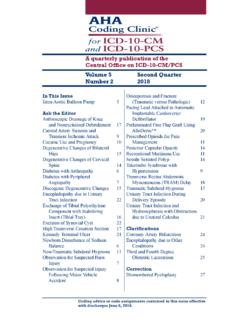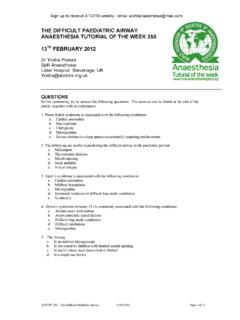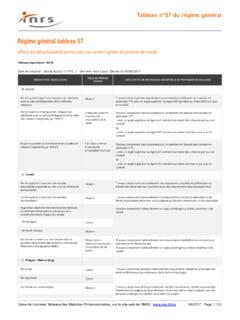Transcription of Bilateral Subdural Hematomas Caused by …
1 J Chin Med Assoc March 2008 Vol 71 No 3147 IntroductionSpontaneous intracranial hypotension (SIH) is causedby spontaneous cerebral spinal fluid (CSF) leakage ofunknown etiology at the level of the spine. Patientspresent with a new headache that occurs shortly afterassuming an upright position and is relieved by lyingdown (orthostatic headache). Although such a posi-tional headache pattern is well-known following a lum-bar puncture, SIH is not well recognized, and thepatient may be diagnosed with migraine, tensionheadache, viral meningitis, or malingering. The spon-taneous form of intracranial hypotension was firstdescribed in 1938, and much has been learned aboutthis syndrome, particularly since the early 1990s, butfrequent initial misdiagnosis SIH among physicians in general and the unusuallyvaried spectrum of clinical and radiographic manifes-tations may all contribute to a delay in diagnosis formonths or even most cases, SIH patients have typical orthosta-tic headaches that generally occur or worsen within15 minutes of assuming the upright position.
2 Theassociated symptoms are neck stiffness, tinnitus, hypa-cusia, photophobia, and nausea. The CSF pressure is low(<60 mmH2O or even negative). Magnetic resonanceimaging (MRI) findings are diffuse pachymeningealenhancement, Subdural fluid collections, engorgementof venous structures, pituitary hyperemia, and saggingof the SIH patients recover after hydration orapplication of epidural blood patches (EBP). If leftuntreated, some SIH patients may encounter thecomplication of Subdural hematoma (SDH) and mayeasily develop neurologic deficits such as cranial nervepalsy,2,3frontotemporal dementia,4parkinsonism,5orcerebral sinus venous only the SDH istreated without diagnosis of SIH, it may result in severeconsequences such as report a SIH patient with Bilateral SDH whocame to our hospital and was discharged 3 weeks laterwithout any neurologic deficit after EBP treatment;there was also no residual or recurrence at the 1-yearfollow-up.
3 The therapeutic timing, modality, and roleof surgical intervention are discussed and the literatureis Subdural Hematomas Caused bySpontaneous Intracranial HypotensionHsin-Hung Chen1,4*, Chun-I Huang1,4, Shu-Shya Hseu2,4, Jiing-Feng Lirng3,41 Department of Neurosurgery, The Neurological Institute, and Departments of 2 Anesthesiology and 3 Radiology, Taipei Veterans General Hospital, and 4 National Yang-Ming University School of Medicine, Taipei, Taiwan, with both spontaneous intracranial hypotension (SIH) and Subdural Hematomas (SDH) are frequently may recur very often over a short interval or result in disastrous consequences if only the SDH is dealt with. We reporta young adult with severe posterior nuchal pain; brain computed tomography showed Bilateral SDH. He was dischargedsmoothly without any neurologic deficit after epidural blood patches were applied after proper and timely with SIH complicated by SDH should not be overlooked.
4 When patients complain of typical orthostaticheadachewithout any history of trauma, SIH should be highly suspected. The therapeutic strategy for this type of SDH is differentfrom those without SIH. We review the literature on the disease. [J Chin Med Assoc2008;71(3):147 151]Key Words:intracranial hypotension, orthostatic headache, Subdural hematoma, surgical intervention 2008 Elsevier. All rights reserved.*Correspondence to: Dr Hsin-Hung Chen, Department of Neurosurgery, The Neurological Institute,Taipei Veterans General Hospital, 201, Section 2, Shih-Pai Road, Taipei 112, Taiwan, : Received: June 29, 2007 Accepted: September 17, 2007 Case ReportA 27-year-old male interior designer was well until hedeveloped sudden onset of posterior neck pain radiatingto Bilateral shoulders after waking up on the morningof July 15, 2006. He denied any history of recenttrauma. The pain became intolerable at noon after hehad been sitting for several hours during work, withthe pain extending to the occipital and forehead discovered that the symptoms were relieved within1 2 minutes after lying down.
5 He went to a hospital semergency department for help and lumbar puncturewas suggested there, but he refused. Brain computed to-mography (CT) was performed instead, which showeda normal result. After intravenous hydration and med-ication, he was discharged without a definite diag-nosis. He noticed, however, that if he maintained anupright position for more than an hour, the symptoms fluctuated thereafter. The posteriornuchal pain was exacerbated 1 week before the patientvisited our outpatient department on August 21, 2006;even lying down did not relieve the pain. Physical andneurologic examinations were normal. Brain CT showedbilateral subacute SDH (1 cm in thickness) with oblit-eration of CSF space (Figure 1). He was admitted onthe same day under the impression of SIH. Brain MRIwith gadolinium contrast demonstrated diffuse pachy-meningeal enhancement, SDH (high signal intensityin both T1- and T2-weighted images), and braindescent with obliteration of basal cisterns, but absenceof midline shift (Figure 2).
6 Therefore, a diagnosis ofSIH was treatment of intravenous hydrationand bed rest were given initially. Whole-spine heavilyT2-weighted MR myelography revealed CSF alongthe left nerve root at the level of T2 and epidural fluidcollection from C2 to the lumbar region (Figure 3A).Two applications of targeted EBPs of 20 mL autologousblood via right side T2 level and 30 mL autologousblood via left side T4 level were performed on the 8thand 10thdays of hospitalization, respectively. The pre-vious symptoms of neck pain and headache subsidedafter the 11thday, and the patient felt even better whenhe was in the upright position. Follow-up 2 weeks laterwith MR myelography demonstrated disappearanceof fluid budding from epidural space of T2 T4, leftside (Figure 3B). The patient was discharged withoutany neurologic deficit on the 20thday of hospitali-zation. The SDH subsided completely, and there wasno recurrence detected on brain CT 4 months later(Figure 4).
7 J Chin Med Assoc March 2008 Vol 71 No Chen, et alABDCF igure axial computed tomography images of the brain show Bilateral Subdural Hematomas , small size of the ventricular systemand obliteration of the basal cistern. The latter 2 findings of spontaneous intracranial hypotension mimic those of increased physician awareness of the disease and improve-ment of diagnostic tools, SIH is half as common asspontaneous subarachnoid hemorrhage, for an esti-mated annual incidence of 5 per 100, wasprobably more frequently underdiagnosed previouslythan it is now, and it is unlikely that there has been anactual increase in its usually affects women more frequently thanmen, with a female-to-male ratio of approximately 2 to patients with chronic SDH or even re-current chronic SDH, it has a reversed epidemiologicfemale-to-male ratio of 1 of symptoms typi-cally occurs in the 4thor 5thdecade of life, with a peak in-cidence around 40 years of age, but children and elderlypersons may also be affected.
8 We think that perhapssome cases of recurrent chronic SDH are Chin Med Assoc March 2008 Vol 71 No 3149 Subdural hematoma Caused by intracranial hypotensionABFigure magnetic resonance images of the brain with intravenous contrast medium injection demonstrate prominentdural (pachymeningeal) enhancement diffusely (black arrows), subacute Subdural hematoma (white arrows) and brain descent withobliteration of the basal cistern. (A) Coronal view; (B) sagittal magnetic resonance myelography revealed: (A) possible cerebral spinal fluid budding (arrow) from the dural sac into thelateral epidural space at the level of T2 on the left side, which (B) disappeared after 2 applications of targeted epidural blood tomography 4 months later shows completeremission of Bilateral Subdural hematoma, and normal appearanceof the cortical sulci and ventricular is Caused by spontaneous spinal CSF leaks.
9 Theprecise cause of spontaneous spinal CSF leaks remainslargely unknown, but an underlying structural weak-ness of the spinal meninges is generally history of a more or less trivial traumatic event ( cough, lifting heavy objects) preceding theonset of symptoms can be elicited in about a third of patients, indicating a role of mechanical is some good evidence to suggest that a gener-alized connective tissue disorder plays a crucial role inthe development of spontaneous spinal CSF leaks, suchas Marfan syndrome, Ehlers-Danlos syndrome type II,and autosomal dominant polycystic kidney ,13 Based on physical examination alone, evidence of anunderlying generalized connective tissue disorder isfound in about 2 thirds of in our patient, brain CT alone cannot be usedto confirm the diagnosis of SIH since the shrinkage ofventricle size and obliteration of basal cisterns cannotbe differentiated from signs of increased intracranialpressure.
10 Along with the typical symptoms of SIH, italerted us for admission and further study. Nonetheless,brain CT is useful for detection of complicated characteristic MRI features of SIH make it theimaging modality of choice for early definite diagnosis,which prevents the risk of cerebral herniation causedby invasive procedures, such as lumbar puncture formyelogram or intracranial pressure monitoring. Fur-ther spinal MRI myelogram may be used to show theongoing leakage sites and the extent of the CSF leaks,which make targeted EBP or percutaneous placementof fibrin sealant possible to perform. However, CTmyelography is still considered the study of choice ifCSF leakage is to be located. Radionuclide cisternog-raphy is usually helpful when diagnosis of SIH is indoubt and myelography results are may sometimes resolve spontaneously, and con-servative treatment of bed rest, oral hydration, a gen-erous caffeine intake, and use of an abdominal binder isalso effective in many patients, but it is time-consumingand the recurrence rate is of ste-roids, intravenous caffeine, or theophylline have all beenadvocated as specific treatments for SIH, but their effec-tiveness is or loop diuretics are noteffective in such cases and may deteriorate the mainstay of treatment is the injection of autol-ogous blood (10 20 mL) into the spinal epidural space,the so-called EBP.





